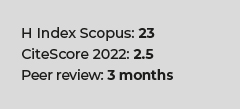Combination therapy of metformin vs dipeptidulpeptidase inhibitors and sulfonylureas in type 2 diabetes: clinical and economic impact
DOI:
https://doi.org/10.17843/rpmesp.2014.314.111Keywords:
Diabetes mellitus, Hypoglycemia, Health care costs, Cardiovascular diseasesAbstract
Objectives. Determine the clinical repurcussions of adherence, metabolic control, hypoglycemia and cardiovascular events (CVE) and economics (resources and costs) in the combination therapy of metformin vs DPP-4 (dipeptidyl peptidase-4) inhibitors and sulfonylureas in patients with type 2 diabetes. Materials and methods. Observational-multicenter and retrospective design. We evaluated patients ≥ 30 years of age in treatment with metformin and who started a second oral antidiabetic treatment during 2008-2009. 2 study groups were established: a) metformin + DPP-4 inhibitors, and b) metformin + sulfonylurea. Main measures: comorbidity, metabolic control (HbA1c <7%), compliance and complications (hypoglycemia, CVE). Follow up was conducted over two years. The cost model differentiated between direct healthcare costs (primary/ specialty care), and indirect costs (labor productivity). Statistical analysis: logistic regression and ANCOVA models. Results. 1,405 patients were recruited (average age 67.1 years old; 56.2% male). 37.0% started a second treatment with DPP-4 inhibitors, and 63.0% with sulfonylureas. After two years of follow up, patients treated with DPP-4 inhibitors showed greater treatment adherence (70.3% vs. 60.6%; p <0.001); better metabolic control (64.3% vs. 60.6%; p<0.001), and a lower proportion of hypoglycemia (13.9% vs. 40.4%; p <0.001, respectively). The average/unit of adjusted total costs was € 2,341 vs. € 2,512; p = 0.038. CVE and renal failure rates were 3.7% vs. 6.4%; p = 0.027. Vildagliptin was the most used drug among DPP-4 inhibitors. Conclusions. Sulfonylureas were the most used drug for diabetes treatment. Patients treated with DPP-4 inhibitors had higher adherence and control of diabetes, with lower rates of hypoglycemia and CVE, resulting in lower healthcare costs.Downloads
Download data is not yet available.
Downloads
Published
2014-12-01
Issue
Section
Research Articles
How to Cite
1.
Sicras-Mainar A, Navarro-Artieda R. Combination therapy of metformin vs dipeptidulpeptidase inhibitors and sulfonylureas in type 2 diabetes: clinical and economic impact. Rev Peru Med Exp Salud Publica [Internet]. 2014 Dec. 1 [cited 2024 Apr. 19];31(4). Available from: https://rpmesp.ins.gob.pe/index.php/rpmesp/article/view/111



























